敦煌莫高窟(英文ppt介绍)
- 格式:ppt
- 大小:17.93 MB
- 文档页数:50
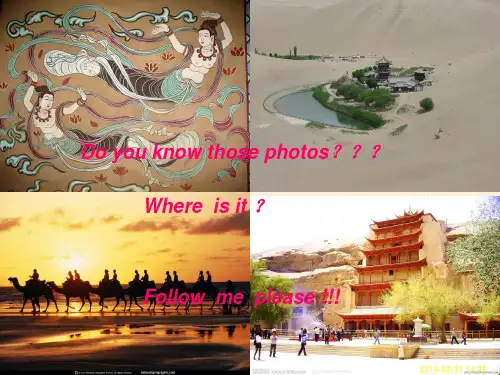
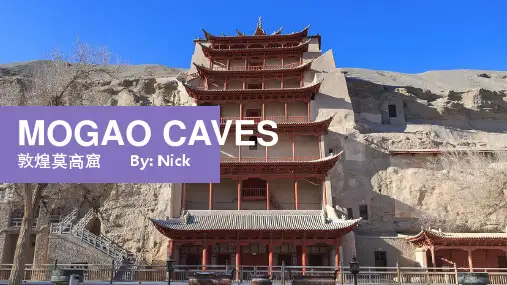
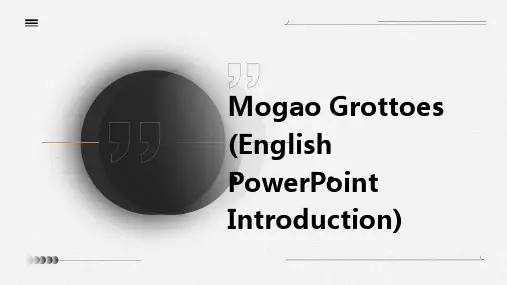
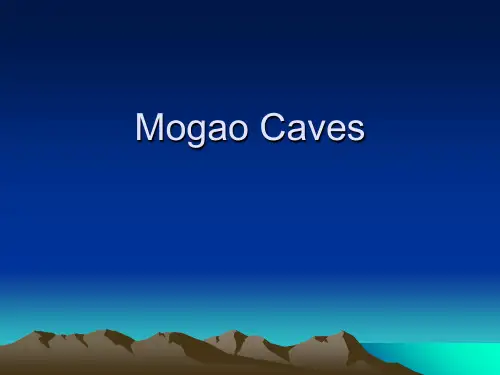

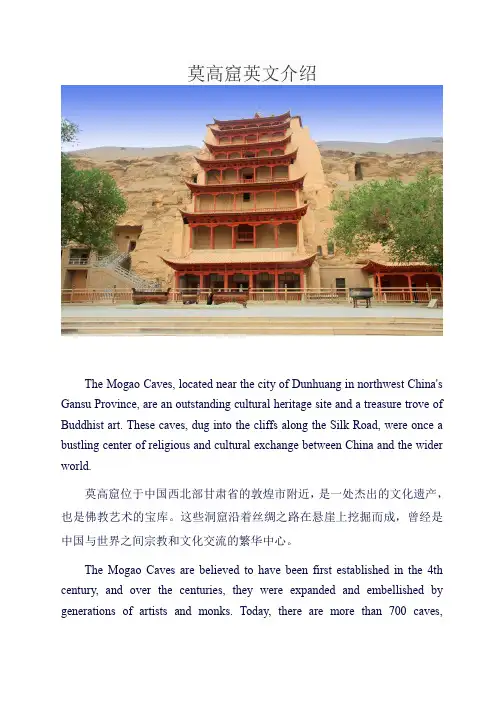
莫高窟英文介绍The Mogao Caves, located near the city of Dunhuang in northwest China's Gansu Province, are an outstanding cultural heritage site and a treasure trove of Buddhist art. These caves, dug into the cliffs along the Silk Road, were once a bustling center of religious and cultural exchange between China and the wider world.莫高窟位于中国西北部甘肃省的敦煌市附近,是一处杰出的文化遗产,也是佛教艺术的宝库。
这些洞窟沿着丝绸之路在悬崖上挖掘而成,曾经是中国与世界之间宗教和文化交流的繁华中心。
The Mogao Caves are believed to have been first established in the 4th century, and over the centuries, they were expanded and embellished by generations of artists and monks. Today, there are more than 700 caves,containing thousands of intricate murals and statues that depict Buddhist legends, historical events, and daily life in ancient China.莫高窟始建于公元4世纪,几个世纪以来,经过一代又一代艺术家和僧侣的不断扩建和装饰。
如今,这里拥有700多个洞窟,内有数千幅错综复杂的壁画和雕像,描绘了佛教传说、历史事件和古代中国的日常生活。

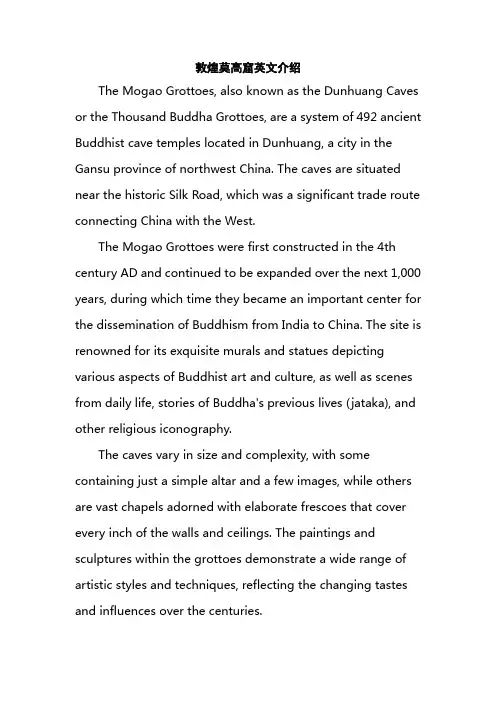
敦煌莫高窟英文介绍The Mogao Grottoes, also known as the Dunhuang Caves or the Thousand Buddha Grottoes, are a system of 492 ancient Buddhist cave temples located in Dunhuang, a city in the Gansu province of northwest China. The caves are situated near the historic Silk Road, which was a significant trade route connecting China with the West.The Mogao Grottoes were first constructed in the 4th century AD and continued to be expanded over the next 1,000 years, during which time they became an important center for the dissemination of Buddhism from India to China. The site is renowned for its exquisite murals and statues depicting various aspects of Buddhist art and culture, as well as scenes from daily life, stories of Buddha's previous lives (jataka), and other religious iconography.The caves vary in size and complexity, with some containing just a simple altar and a few images, while others are vast chapels adorned with elaborate frescoes that cover every inch of the walls and ceilings. The paintings and sculptures within the grottoes demonstrate a wide range of artistic styles and techniques, reflecting the changing tastes and influences over the centuries.In addition to their artistic significance, the Dunhuang Caves are also a treasure trove for scholars studying history, religion, language, and cultural exchange along the Silk Road. Among the discoveries made here is the famous Dunhuang Manuscript Library, a hidden room filled with thousands of immaculately preserved documents and textiles dating from the 5th to the 11th centuries.Today, the Mogao Grottoes are a UNESCO World Heritage Site and one of the most celebrated cultural landmarks in China, attracting visitors from around the globe who come to marvel at the ancient artwork and learn about the rich heritage of the Silk Road.。
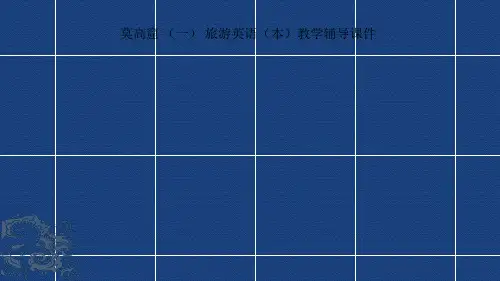
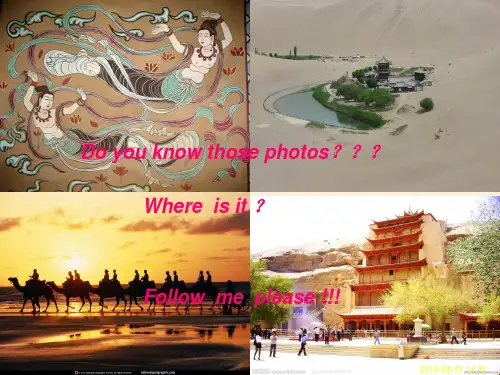
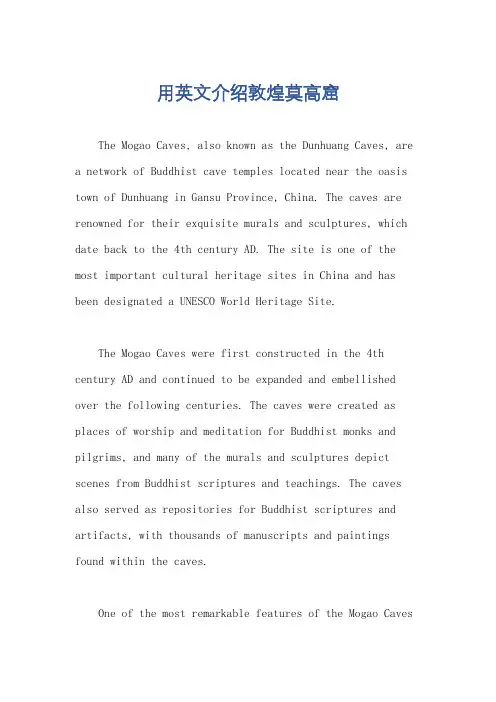
用英文介绍敦煌莫高窟The Mogao Caves, also known as the Dunhuang Caves, are a network of Buddhist cave temples located near the oasis town of Dunhuang in Gansu Province, China. The caves are renowned for their exquisite murals and sculptures, which date back to the 4th century AD. The site is one of the most important cultural heritage sites in China and has been designated a UNESCO World Heritage Site.The Mogao Caves were first constructed in the 4th century AD and continued to be expanded and embellished over the following centuries. The caves were created as places of worship and meditation for Buddhist monks and pilgrims, and many of the murals and sculptures depict scenes from Buddhist scriptures and teachings. The caves also served as repositories for Buddhist scriptures and artifacts, with thousands of manuscripts and paintings found within the caves.One of the most remarkable features of the Mogao Cavesis the diversity of artistic styles and influences found in the murals and sculptures. The artwork in the cavesreflects a blend of Chinese, Indian, and Central Asian artistic traditions, showcasing the cultural exchange and religious syncretism that characterized the Silk Road region during this period. The caves also contain some of the earliest known examples of Chinese landscape painting, with detailed depictions of mountains, rivers, and forests.In addition to their artistic significance, the Mogao Caves are also important for their historical and archaeological value. The caves provide valuable insights into the religious beliefs, social practices, and artistic achievements of the various cultures that inhabited the region over the centuries. The discovery of the Dunhuang Manuscripts in the early 20th century further enhanced the site's importance, shedding light on the intellectual and cultural life of medieval China.Today, the Mogao Caves are a popular tourist destination, attracting visitors from around the world who come to marvel at the beauty and historical significance ofthe site. The caves have been carefully preserved and restored, with ongoing efforts to protect the fragile murals and sculptures from damage due to environmental factors and tourism. The Mogao Caves continue to inspire awe and wonder, serving as a testament to the rich cultural heritage of China and the enduring legacy of Buddhism in the region.。
敦煌莫高窟英语介绍The Mogao Caves, also known as the Thousand Buddha Grottoes, are located at the foot of Mingsha Mountain, 25 kilometers southeast of Dunhuang City in Gansu Province. They are the largest and most richly endowed Buddhist art site in the world that still exists today. The construction of the Mogao Caves began during the Qin Dynasty of the Sixteen Kingdoms period and continued through the Northern and Southern Dynasties, Sui, Tang, Five Dynasties, Western Xia, and Yuan dynasties, resulting in a massive scale with 735 caves, 45,000 square meters of murals, and 2,415 clay sculptures. It is a treasure house of grotto art.The Mogao Caves are an artistic palace that combines ancient architecture, sculpture, and painting, with its colorful murals being particularly renowned worldwide. The scale and content of Dunhuang murals are unparalleled in any religious art in the world today. Looking around the caves' walls and ceilings, one can find images of Buddha, Apsarases (heavenly dancers), musicians, and fairy maidens.The Mogao Caves are a large grotto temple that integrates painting, sculpture, and architectural art. Its main grotto types include meditation caves, central tower caves, hall caves, central Buddha altar caves, three-alcove caves with four walls, giant statue caves, and Nirvana caves. The sizes of the various caves vary greatly; the largest, Cave 16, covers an area of 268 square meters, while the smallest, Cave 37, is only a few inches high. There used to be wooden halls outside the caves connected by corridors and plank roads, but most have now disappeared.In conclusion, the Mogao Caves are a place worth visiting for their long history and profound cultural heritage. They are well-preserved and allow visitors to experience the charm of ancient civilization up close.翻译:敦煌莫高窟,又称千佛洞,位于甘肃省敦煌市东南25公里处的鸣沙山麓脚下,是世界上现存规模最大、内容最丰富的佛教艺术地。
莫高窟(mògāo kū)Mogao GrottoesSpiritual, artistic and architectural wonders The Mogao Grottoes in northwest China are the greatest Buddhist caves, and the second oldestafter the Qiuci Grottoes in Xinjiang Uygur Autonomous Region still in existence in the countrytoday.Also known as the Caves of a Thousand Buddhas, the grottoes are about 25 kilometers southeastof Dunhuang in Gansu Province, a strategic center for trade, as well as a hub for cultural andreligious exchanges on the Silk Road in ancient times.Construction of the caves began in the 4th century AD. According to a legend, Buddhist monk Le Zun saw 1,000 Buddhas bathed in golden light at thesite. He then decided to dig a cave into the cliff to create a place for mediation while pursuing hisquest for enlightenment.Gradually, more Buddhist monks came here to dig caves into the cliff of the east range of MountMingsha. The caves served as both their homes and places to meditate.Later, caves began to be carved out of the southern side of the cliff to serve as places for worshipand pilgrimage.By the T ang Dynasty (618–907 AD) there were more than 1,000 grottoes.Today, 735 caves, which contain numerous murals and 2,415 statues of Buddha, still exist.Distributed on four levels and stretching 1,680 meters from south to north, the floor space ofeach cave varies from more than 200 square meters to less than one square meter.Since the grottoes on the north section of the cliff once served as mediation chambers, livingquarters and burial sites, they are simpler in design. But those on the south section are richlypainted and built in various styles as places for worship and pilgrimage.The main chambers of these caves feature distinctive architectural styles such as chaitya, nirvanaand grand Buddha.Cave No. 96 houses a sitting statue of Buddha measuring 35.6 meters in height.The chaitya style has a square-sectioned column standing in the center of the chamber,representing Buddha. Worshipers would circle around the column seeking blessings.Grottoes in the nirvana style are usually a rectangular chamber with a landscape orientation. Astatue of a reclined Buddha is placed on a platform built along the back wall and open forworshipers.A cave for a grand Buddha statue is often built according to the size of the statue. For instance,Cave No. 96 houses a sittingstatue of Buddha measuring 35.6 meters tall. It is made of stone andcolored with clay.Such caves all have a square base and the walls taper toward the ceiling, which is usually in theshape of a dome or a flat-top pyramid.Cave No. 96 was built in the early years of the Tang Dynasty. The cave is inside a tall andgrandiose pavilion featuring nine flying eaves, which were rebuilt in the 1930s.There are also caves that imitate traditional Chinese buildings and Buddhist architecture.Some of the grottoes once had wooden porches, but they have nearly all been lost due toerosion or destruction. There are several relatively well-preserved extant wooden eaves at the entrance of some caves.They are rare samples of the wooden structures prevalent in the Tang and Song (960–1279)dynasties.The large murals inside the caves have great artistic value. However, they are also treasured byarchitects and historians since they depict ancient buildings such as palaces, temples, pavilions,city walls, tents, bridges, prisons, beacon towers,taverns, wine shops and tombs.In 1987, the Mogao Grottoes were added to the list of UNESCO World Heritage Sites. Today it isone of the most popular tourist attractions in the country.Buddha statues in Maiji Mountain Grottoes Pictorial dictionary·石窟寺(shíkūsì) cave templeCave temples are a type of rock-cut architecture that China first introduced from India in the 3rdcentury AD, when Chinese Buddhist monks began to build caves in cliffs and used themasmediation chambers and living quarters.Later, more caves were chiseled out to serve as Buddhist temples for worship and pilgrimage.The best-known cave temples in China include the Mogao Grottoes, Maiji Mountain Grottoes,Yungang Grottoes and Longmen Grottoes. They are all fine examples of Chinese Buddhist art,combining architecture with sculptures and paintings.Most of these caves were built in one of six distinctive architecture styles.One is called chaitya, featuring a square-section column in the center of the cave. Worshiperscircle the column seeking blessings.Some large grottoes were built to house large Buddha statues, some of which are nearly 40meters tall.Others have combined the Buddhist style with traditional Chinese buildings.Cave temples have long been deemed a part of ancient Chinese architecture.。
莫高窟英语介绍Mogao Grottoes is a famous treasure trove of cave art in China, located in Mogao Valley, Dunhuang City, Gansu Province. It is the largest and most abundant Buddhist art site in the world, and also one of the treasures of ancient Chinese art. The Mogao Grottoes were first built during the Pre Qin period of the Sixteen Kingdoms period, and have undergone construction and development during historical periods such as the Sixteen Kingdoms, Northern Dynasties, Sui, Tang, Five Dynasties, Western Xia, and Yuan, forming the current scale.The total area of Mogao Grottoes has reached 45000 square meters, divided into three parts: east, middle, and west, with a total of 735 caves. Among them, there are 492 well preserved caves, with over 45000 square meters of murals and over 2415 sculptures. These caves and mural sculptures are renowned for their exquisite artistic techniques and rich subject matter content.The murals in Mogao Grottoes mainly depict Buddhist stories, the life stories of Buddha, and important scenes in Buddhist scriptures. These murals not only have high artistic value, but also have important significance for studying ancient Chinese society, culture, religion, and other aspects. The sculpture works of Mogao Grottoes are also unique, featuring typical features of the Tang Dynasty and incorporating the influence of Western culture, forming a unique style.The murals and sculptures of Mogao Grottoes occupy an important position in the history of ancient Chinese art. They not only showcase the brilliant achievements of ancient Chinese art, but also reflect the historical process of cultural exchange andintegration between East and West. The Mogao Grottoes are therefore known as the "treasure trove of Eastern sculpture art".The Mogao Grottoes are not only renowned in China and even globally, but also one of China's important tourist attractions. Every year, it attracts a large number of domestic and foreign tourists to watch and study. In order to protect the valuable cultural heritage of the Mogao Grottoes, the Chinese government has taken a series of measures, such as limiting the number of tourists and strengthening the protection of cultural relics. At the same time, modern technological means have been utilized for digital protection and research of the Mogao Grottoes, in order to better inherit and showcase this valuable cultural heritage.In short, the Mogao Grottoes, as one of the treasures of ancient Chinese art, are renowned for their rich and diverse murals and sculpture works. It is not only a treasure of ancient Chinese art, but also a witness to the exchange and integration of Chinese and Western cultures. By protecting and inheriting the precious cultural heritage of the Mogao Grottoes, we can better understand and appreciate the glorious achievements of ancient Chinese art. At the same time, the Mogao Grottoes also provide visitors from all over the world with a window to learn about ancient Chinese culture and art.。